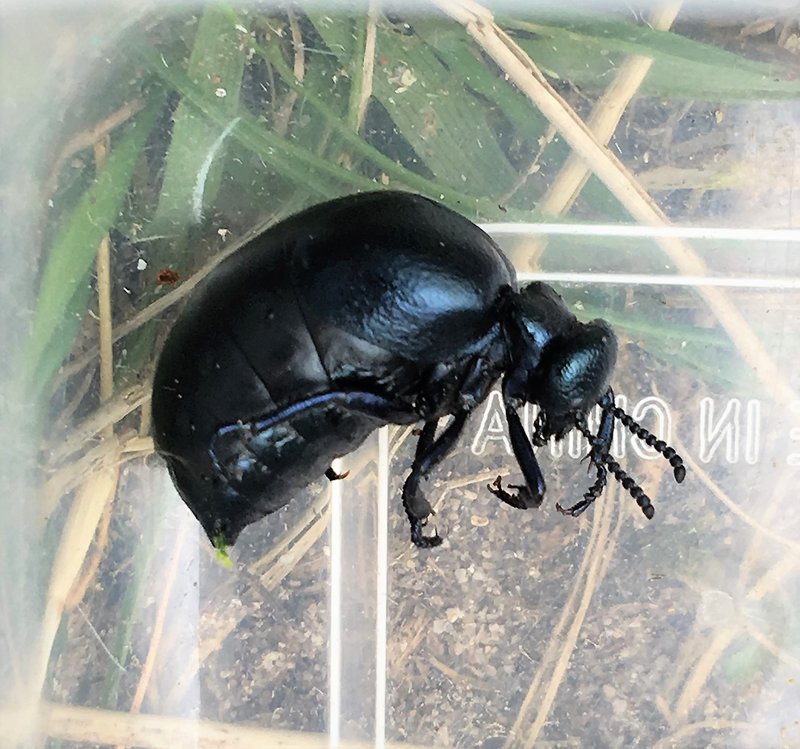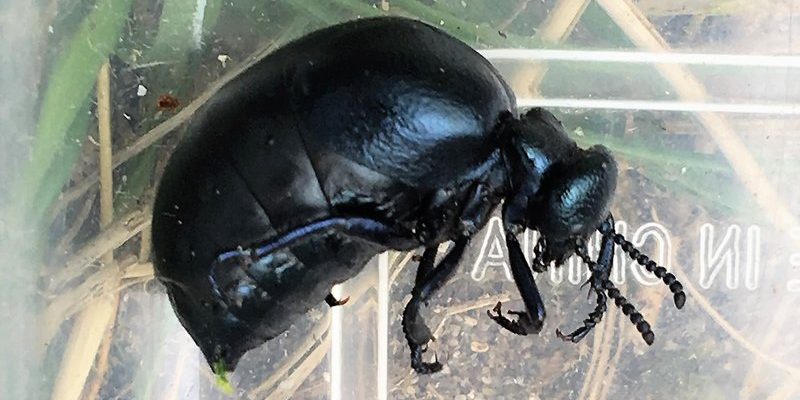
Oil beetles are intriguing little creatures that belong to the family Meloidae. These beetles are not just any ordinary insects; they have a few remarkable qualities that set them apart. Imagine a tiny, shiny bug that can produce a fluid resembling oil—hence the name “oil beetle.” They’re known for their distinctive body shapes, often plump and softly rounded, which can be quite striking when you spot them in your garden or on a nature walk.
But here’s the twist: oil beetles are also excellent mimics. They have a fascinating lifecycle that involves a parasitic relationship with solitary bees. In their larval stage, they cleverly manipulate the lives of these bees to ensure their own survival. So, when you see one of these beetles, you’re not just observing an insect; you’re witnessing a small piece of nature’s complex web of life.
Physical Characteristics
Oil beetles can vary in size, but most typically range from about 1 to 3 centimeters long. Their bodies are usually black or dark blue, with a somewhat shiny appearance that can catch your eye easily. One of the most interesting features of oil beetles is their soft, oily body texture. You might even think they look a bit like a small, chunky version of the common ladybug if you squint a bit.
These beetles also have long legs and extended antennae, which aid them in navigating their surroundings. Their wings, while present, are often short or non-functional, which means these beetles are not flying around much. Instead, they prefer to crawl around on the ground, often seen in grassy areas or near blooming flowers where they can be on the lookout for potential mates or host bees.
Oil Beetle Habitats
Oil beetles are quite versatile regarding their habitats. You can often find them in a variety of environments, ranging from meadows and grasslands to gardens and wooded areas. They tend to prefer areas with plenty of flowers, as these spots attract the solitary bees they rely on for their lifecycle. Think about it: the next time you’re out walking in a sunny meadow filled with wildflowers, you might spot one of these little fellows crawling around!
Despite their adaptability, oil beetles do have a preference for areas that provide ample cover, such as leaf litter or underbrush, where they can hide from predators. Since they are not particularly fast movers, having a safe place to retreat is crucial for their survival. Additionally, moisture-rich environments are essential for them, as they tend to thrive in areas where the humidity is just right.
Diet and Feeding Habits
What do oil beetles eat? It’s a bit different than what you might expect. Adult oil beetles primarily consume plant material, particularly flowers and plant leaves. They have strong mandibles that allow them to chew through tough plant fibers. You might see them munching on various types of grasses and wildflowers, playing a vital role in the ecosystem by aiding in plant pollination.
But here’s the catching part: the oil beetle’s larvae have a unique feeding strategy. When they hatch, they’re not directly eating plants. Instead, they seek out solitary bees. The oil beetle larvae will attach themselves to a bee as it visits flowers. Once aboard, they sneak into the bee’s nest, where they may consume the bee’s eggs and the pollen stored for the future larvae. It’s a rough start to life for these young beetles, but that’s just how nature rolls sometimes!
Life Cycle of an Oil Beetle
The life cycle of an oil beetle is quite remarkable and a bit convoluted. It begins when adult oil beetles emerge in the spring or early summer. After mating, female beetles lay their eggs in the soil. Once the eggs hatch, the larvae enter their first stage, which involves a fascinating but slightly macabre interaction with solitary bees.
Here’s how it works: the larvae climb onto flowers and wait for a hapless bee to arrive. Once a bee comes by, the larvae attach themselves and hitch a ride back to the bee’s nest. Once there, they consume the pollen and, often, the eggs laid by the bee. This parasitic relationship ensures that oil beetles have a food source to thrive during their early stages.
After a while, the larvae grow and eventually turn into pupae before emerging as adults. The entire process can take a few months, and it’s essential for the beetles to find a suitable host to ensure their larvae have the best chance of survival. Isn’t it fascinating how different species interact in nature’s complex dance?
Interesting Facts about Oil Beetles
| Size: | 1 to 3 cm |
| Color: | Black or dark blue |
| Habitat: | Grasslands, gardens, meadows |
| Diet: | Plant material, particularly flowers and leaves |
| Unique Lifecycle: | Parasitizes solitary bees |
| Predators: | Birds, mammals, and other insects |
Why Are Oil Beetles Important?
Every creature plays a role in the ecosystem, and oil beetles are no exception. They contribute to biodiversity by serving as both pollinators and prey for various animals. As they feed on plants, they help in the process of pollination, supporting the growth of flowers and the broader plant community.
Moreover, their relationship with solitary bees highlights the intricate connections in nature. Their parasitic behavior may seem harsh, but it’s a part of the balance that keeps ecosystems functioning. By understanding the role of these beetles, we can better appreciate the delicate web of life around us.
Additionally, some oil beetle species are indicators of environmental health. As they thrive in specific habitats, their presence can tell us a lot about the condition of the local ecosystem. Monitoring these beetles can help scientists gauge environmental changes, making them valuable to research and conservation efforts.
Conservation Status of Oil Beetles
Unfortunately, many oil beetle species are experiencing declines due to habitat loss, pesticides, and climate change. As their natural habitats are developed or altered, these beetles struggle to find suitable environments to thrive. This has led to some species becoming rare, while others are at risk of extinction.
Conservation efforts are critical for ensuring the survival of oil beetles and the ecosystems they inhabit. Protecting natural habitats, promoting organic farming, and increasing public awareness about these fascinating insects can make a significant difference. It’s essential to share the importance of oil beetles with others so we can work together to protect them.
You can help, too! Supporting local conservation groups or participating in butterfly and bee-friendly gardening practices can create a welcoming environment for oil beetles and other beneficial insects. It’s a small step, but every little bit counts in the fight for biodiversity.
FAQ
What are the main predators of oil beetles?
Oil beetles face threats from a variety of predators. Birds, small mammals, and even other insects enjoy munching on these beetles. Because oil beetles have a soft body, they can be an easy target for hungry foragers. Their ability to produce a foul-smelling liquid can deter some predators, but it doesn’t eliminate the risk entirely.
Can oil beetles harm humans?
Generally, oil beetles are harmless to humans. However, they do secrete a fluid that can irritate the skin if handled. It’s best to admire them from a distance instead of picking them up. If you accidentally come into contact with one, just wash the affected area with soap and water. It’s always a good idea to avoid handling any wild insects!
How long do oil beetles live?
The lifespan of oil beetles varies by species, but on average, they can live from a few months up to two years. Factors such as environmental conditions, availability of food, and predation can influence their life expectancy. During their short lives, oil beetles go through significant life stages, from larvae to adult beetles, each with its own challenges.
Are oil beetles endangered?
Some species of oil beetles are indeed at risk. Habitat destruction, pesticides, and climate change are significant threats to their populations. Conservation efforts are vital to protecting these interesting creatures and ensuring they continue to thrive in their natural environments.
How can I attract oil beetles to my garden?
You can create a welcoming environment for oil beetles by planting a variety of flowering plants that attract solitary bees. By encouraging bee populations, you also provide a food source for the beetles. Avoiding pesticides and chemicals in your garden will help maintain a healthy ecosystem, allowing oil beetles to flourish.
Do oil beetles have any interesting behaviors?
Yes, oil beetles have some fascinating behaviors! One of the most intriguing is their mimicry of solitary bees during the larval stage. Their clever approach of attaching to bees to access nests is quite unique among insects. Adult oil beetles are also known to be somewhat sluggish, preferring to crawl rather than fly, which adds to their charm.
What should I do if I find an oil beetle?
If you spot an oil beetle, it’s best to observe it from afar. Take note of its unique features and enjoy watching it in its natural habitat. If you encounter one in your home, gently guide it outside using a piece of paper or a small container. Always handle wildlife with care to ensure their safety and well-being.
Can oil beetles be kept as pets?
While it may be tempting to keep an oil beetle as a pet due to its fascinating characteristics, it’s not advisable. These beetles have very specific habitat and dietary needs that can be challenging to replicate in a home environment. It’s best to admire them in the wild, where they thrive naturally.
Are oil beetles beneficial for the environment?
Absolutely! Oil beetles play an essential role in their ecosystems. As they feed on plants, they assist in pollination, which is vital for plant reproduction. Their unique lifecycle also emphasizes the importance of biodiversity, as they rely on solitary bees for their survival, showcasing the interconnectedness of various species in nature.
How can I learn more about oil beetles?
There are many ways to learn more about oil beetles! You can explore books and articles focused on entomology or engage with local nature groups that offer educational programs on insects. Field guides are also a fantastic resource, providing detailed descriptions and identification tips. Watching documentaries about insects can provide fascinating insights into their lives and habitats.
Is there a specific time of year to see oil beetles?
The best time to spot oil beetles is typically during the spring and early summer months when they are most active. They emerge from the soil to mate and lay eggs, making this period ideal for observation. During this time, they can often be seen crawling around flowers and meadows, making them easier to find!

